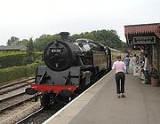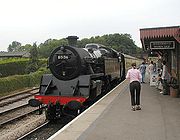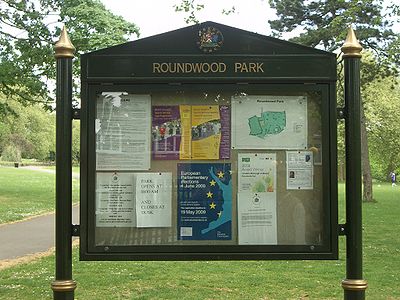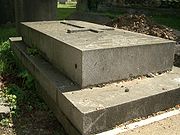
George Furness
Encyclopedia
George Furness was a Victorian
construction engineer and benefactor. He described himself as a "contractor of public works". He worked all around the world, on railways, drainage
, and brickwork
among numerous other things.
, Derbyshire
. The old Croft House was part of the Furness' property there.

of major railways in the Midlands, Western and Southern counties of England.
Among those he contributed to were:
Some of these still exist.

and France
.
His other specialty was public works
. He worked on extensive dredging contracts in Italy
(Spezia, Ancona
, Livorno
and Palermo
) for the next 30 years of his life. King Victor Emmanuel III made him a Knight of the Order of the Crown of Italy
.
His main work, though, was in Odessa, Russia. After the Crimean War
, specialists were needed to renew public works. There, he worked on drainage, paving, and general restorations, along with numerous other works. The overall cost for these labours totalled £750,000.

. In 1856, Metropolitan Board of Works
was formed and was put in charge of constructing London's first sewage system
.
Furness bid for the major section of the Thames Embankment
(from Westminster
to Waterloo Bridge
) and won the contract for £520,000. The work began in 1864. Despite slow progress created by friction with his partner, problems with materials, and also financial difficulties, his large section of the embankment was complete by 1870.
His other, and somewhat smaller, contract was the Northern Lower Level Sewer Isle of Dogs
Branch, in 1865, valued at £75,456.

 In the 1870s, a sudden explosion of the construction of houses in Willesden and surrounding areas motivated Furness to form the Willesden Brick and Tile Company, situated on Chambers Lane.
In the 1870s, a sudden explosion of the construction of houses in Willesden and surrounding areas motivated Furness to form the Willesden Brick and Tile Company, situated on Chambers Lane.
Soon after, an approximately 140 feet (42.7 m)-high swauer chimney puffed steam and smoke, from many kilns, over the surrounding area. The machinery was powered by a steam engine. It manufactured high-quality, and therefore expensive, durable red bricks. It also made cheaper brown stock bricks. Furness bought large plots of land in the area for his works. These were developed, from pasture land, into residential premises, providing houses, roads and drainage to the whole community.
Many houses, made from these bricks, still house the current Willesden's residents. These include some houses on Ashford Road, Cedar Road, Cricklewood Broadway, Harlesden Road, Ivy Road, Larch Road, Longstone Terrace, Mora Road, Pine Road, and Taylors Lane
Furness' bricks were used to erect St. Andrew Church. Schools in Willesden
, a number of other churches, along with a school in the surrounding areas also benefited from his brickfactory. The Brick and Tile Company also produced vases, flower pots, drain pipes, glazed bricks, and roof tiles.
Furness became one of Willesden's major employers. Many company houses were provided to rent out to employees; those on Parkfield Road are an example.
His children were, in order of birth:
Three of their children did not manage to survive infancy.
After Furness completed his overseas work, he remained in England
to do the remainder of his labours. Living in Willesden
, he was able to spend more time with his family. His eldest son, George James Furness, attended the Crystal Palace School of Engineering as a teenager, graduated to become an engineer, and worked with his father.
Roundwood House remained part of their property from till 1936. The old Croft House in Great Longstone, Derbyshire (Furness' hometown), continued to remain among their property.
and hence became the first chairman. Later on, he represented South Kilburn and East Willesden
.
Furness was elected as one of the first representatives to the Middlesex County Council
in 1889. He also sat on the Hendon Board of Guardians for many years, and was one of the original members of the School Board.
at St. Mary Church, where he was putting his practical knowledge to good uses.
 Concerning hospitals, he financially supported the Willesden Cottage Hospital. He was also a governor at St. Mary Hospital.
Concerning hospitals, he financially supported the Willesden Cottage Hospital. He was also a governor at St. Mary Hospital.
and oak trees. This eventually became, after much work by Oliver Claude Robson (Surveyor
for the Willesden Local Board and later Willesden District Council), the Roundwood Park
today, situated in Willesden
.
 Furness' youngest daughter, Agnes Sophia, was murdered by her husband in India
Furness' youngest daughter, Agnes Sophia, was murdered by her husband in India
in 1899. She was buried in Bandora Churchyard, in Bombei, India. Since that time, Furness' health began to decline, as he suffered from bronchitis
and influenza
.
On January 9, 1900, George Furness, aged 79, died at Roundwood House, Willesden
. He is interred in the churchyard of St. Mary Church, Willesden.
His obituary stated: "In public affairs his tenacity of purpose, liberal views, and ready regard for divergent opinions were as noticeable in his private and professional life."
, in Ireland
. Only the body of Sarah Rebecca was recovered, and her corpse was brought back to Willesden and laid to rest next to her husband.
George James, Furness' eldest son and only surviving heir, carried on the tradition of his father in Willesden. He sat on the Middlesex County Council
and was a JP, MP for West Willesden from 1922 to 1923 and High Sheriff of Middlesex
. After his death in 1963, his family decided to move out of Willesden
. He was buried too in St Mary Church, across the path from his father and mother.
Roundwood House was sold to Willesden District Council on that same year. It no longer stands today because, in an act of civiv vandalism
, it was destroyed. The brickwork factory was also sold and demolished.

 For his contribution to the local community, a road was named after him. It remains to this day; Furness Road. There is also a school named Furness Primary School on that road.
For his contribution to the local community, a road was named after him. It remains to this day; Furness Road. There is also a school named Furness Primary School on that road.
Additionally, a block of flats is called George Furness House. They stand on Grange Road.
Victorian era
The Victorian era of British history was the period of Queen Victoria's reign from 20 June 1837 until her death on 22 January 1901. It was a long period of peace, prosperity, refined sensibilities and national self-confidence...
construction engineer and benefactor. He described himself as a "contractor of public works". He worked all around the world, on railways, drainage
Drainage
Drainage is the natural or artificial removal of surface and sub-surface water from an area. Many agricultural soils need drainage to improve production or to manage water supplies.-Early history:...
, and brickwork
Brickwork
Brickwork is masonry produced by a bricklayer, using bricks and mortar to build up brick structures such as walls. Brickwork is also used to finish corners, door, and window openings, etc...
among numerous other things.
Birth
Furness was born in Great LongstoneGreat Longstone
Great Longstone with Little Longstone is one of two villages in the local government district of Derbyshire Dales in Derbyshire, England.-History:...
, Derbyshire
Derbyshire
Derbyshire is a county in the East Midlands of England. A substantial portion of the Peak District National Park lies within Derbyshire. The northern part of Derbyshire overlaps with the Pennines, a famous chain of hills and mountains. The county contains within its boundary of approx...
. The old Croft House was part of the Furness' property there.
Career
George Furness did a wide variety of jobs and contracts throughout his life, both overseas and local.
Railway
In the early 19th century, the railway was born in Britain. Furness took advantage of this new type of business; from 1842 onwards, he worked on the constructionConstruction
In the fields of architecture and civil engineering, construction is a process that consists of the building or assembling of infrastructure. Far from being a single activity, large scale construction is a feat of human multitasking...
of major railways in the Midlands, Western and Southern counties of England.
Among those he contributed to were:
- Abingdon Railway, opened in 1856
- Redditch Railway, opened in 1859
- West Somerset RailwayWest Somerset RailwayThe West Somerset Railway is a railway line that originally linked and in Somerset, England.It opened in 1862 and was extended from Watchet to by the Minehead Railway in 1874. Although just a single track, improvements were needed in the first half of the twentieth century to accommodate the...
, open in 1862 - Isle of GrainIsle of GrainThe Isle of Grain, in the north of Kent, England, is the easternmost point of the Hoo Peninsula. No longer an island, the Isle is almost all marshland and the Grain Marshes are an important habitat for birdlife...
to (Kent), opened in 1882
Some of these still exist.

Overseas work
When Britain was at the forefront of construction and engineering, specialists where in great demand overseas for their skills. Furness, being one of these skilled workers, was involved in overseas construction works in BrazilBrazil
Brazil , officially the Federative Republic of Brazil , is the largest country in South America. It is the world's fifth largest country, both by geographical area and by population with over 192 million people...
and France
France
The French Republic , The French Republic , The French Republic , (commonly known as France , is a unitary semi-presidential republic in Western Europe with several overseas territories and islands located on other continents and in the Indian, Pacific, and Atlantic oceans. Metropolitan France...
.
His other specialty was public works
Public works
Public works are a broad category of projects, financed and constructed by the government, for recreational, employment, and health and safety uses in the greater community...
. He worked on extensive dredging contracts in Italy
Italy
Italy , officially the Italian Republic languages]] under the European Charter for Regional or Minority Languages. In each of these, Italy's official name is as follows:;;;;;;;;), is a unitary parliamentary republic in South-Central Europe. To the north it borders France, Switzerland, Austria and...
(Spezia, Ancona
Ancona
Ancona is a city and a seaport in the Marche region, in central Italy, with a population of 101,909 . Ancona is the capital of the province of Ancona and of the region....
, Livorno
Livorno
Livorno , traditionally Leghorn , is a port city on the Tyrrhenian Sea on the western edge of Tuscany, Italy. It is the capital of the Province of Livorno, having a population of approximately 160,000 residents in 2009.- History :...
and Palermo
Palermo
Palermo is a city in Southern Italy, the capital of both the autonomous region of Sicily and the Province of Palermo. The city is noted for its history, culture, architecture and gastronomy, playing an important role throughout much of its existence; it is over 2,700 years old...
) for the next 30 years of his life. King Victor Emmanuel III made him a Knight of the Order of the Crown of Italy
Order of the Crown of Italy
The Order of the Crown of Italy was founded as a national order in 1868 by King Vittorio Emanuele II, to commemorate the unification of Italy in 1861...
.
His main work, though, was in Odessa, Russia. After the Crimean War
Crimean War
The Crimean War was a conflict fought between the Russian Empire and an alliance of the French Empire, the British Empire, the Ottoman Empire, and the Kingdom of Sardinia. The war was part of a long-running contest between the major European powers for influence over territories of the declining...
, specialists were needed to renew public works. There, he worked on drainage, paving, and general restorations, along with numerous other works. The overall cost for these labours totalled £750,000.

Drainage
Half way through the 19th century, the rapid growth of population and the poor state of public works in London caused high pollution of the River ThamesRiver Thames
The River Thames flows through southern England. It is the longest river entirely in England and the second longest in the United Kingdom. While it is best known because its lower reaches flow through central London, the river flows alongside several other towns and cities, including Oxford,...
. In 1856, Metropolitan Board of Works
Metropolitan Board of Works
The Metropolitan Board of Works was the principal instrument of London-wide government from 1855 until the establishment of the London County Council in 1889. Its principal responsibility was to provide infrastructure to cope with London's rapid growth, which it successfully accomplished. The MBW...
was formed and was put in charge of constructing London's first sewage system
London sewerage system
The London sewerage system is part of the water infrastructure serving London. The modern system was developed during the late 19th century, and as London has grown the system has been expanded.-History:...
.
Furness bid for the major section of the Thames Embankment
Thames Embankment
The Thames Embankment is a major feat of 19th century civil engineering designed to reclaim marshy land next to the River Thames in central London. It consists of the Victoria and Chelsea Embankment....
(from Westminster
Westminster
Westminster is an area of central London, within the City of Westminster, England. It lies on the north bank of the River Thames, southwest of the City of London and southwest of Charing Cross...
to Waterloo Bridge
Waterloo Bridge
Waterloo Bridge is a road and foot traffic bridge crossing the River Thames in London, England between Blackfriars Bridge and Hungerford Bridge. The name of the bridge is in memory of the British victory at the Battle of Waterloo in 1815...
) and won the contract for £520,000. The work began in 1864. Despite slow progress created by friction with his partner, problems with materials, and also financial difficulties, his large section of the embankment was complete by 1870.
His other, and somewhat smaller, contract was the Northern Lower Level Sewer Isle of Dogs
Isle of Dogs
The Isle of Dogs is a former island in the East End of London that is bounded on three sides by one of the largest meanders in the River Thames.-Etymology:...
Branch, in 1865, valued at £75,456.
Brickwork


Soon after, an approximately 140 feet (42.7 m)-high swauer chimney puffed steam and smoke, from many kilns, over the surrounding area. The machinery was powered by a steam engine. It manufactured high-quality, and therefore expensive, durable red bricks. It also made cheaper brown stock bricks. Furness bought large plots of land in the area for his works. These were developed, from pasture land, into residential premises, providing houses, roads and drainage to the whole community.
Many houses, made from these bricks, still house the current Willesden's residents. These include some houses on Ashford Road, Cedar Road, Cricklewood Broadway, Harlesden Road, Ivy Road, Larch Road, Longstone Terrace, Mora Road, Pine Road, and Taylors Lane
Furness' bricks were used to erect St. Andrew Church. Schools in Willesden
Willesden
Willesden is an area in North West London which forms part of the London Borough of Brent. It is situated 5 miles north west of Charing Cross...
, a number of other churches, along with a school in the surrounding areas also benefited from his brickfactory. The Brick and Tile Company also produced vases, flower pots, drain pipes, glazed bricks, and roof tiles.
Furness became one of Willesden's major employers. Many company houses were provided to rent out to employees; those on Parkfield Road are an example.
Family
Furness married Sarah Rebecca (1835 – 1902) in his early forties and they moved into the Roundwood House in 1856, an Elizabethan-style mansion, which was originally built around 1836 for Lord Decies.His children were, in order of birth:
- George James Furness (1868 – 1935, aged 67 years), who was member of parliamentMember of ParliamentA Member of Parliament is a representative of the voters to a :parliament. In many countries with bicameral parliaments, the term applies specifically to members of the lower house, as upper houses often have a different title, such as senate, and thus also have different titles for its members,...
for the constituency of Willesden West on behalf of the Conservative party from 1922-1923 .- Mary Woodwis Furness (1866 – 1902, aged 36 years)
- Matthew Thomas Bladen Furness (1870 – 1902, aged 32 years)
- Agnes Sophia Furness (1876 – 1899, aged 23 years)
- George John Furness (1865, aged 2 days)
- John Furness (1871, aged 1 month)
- Sarah Furness (1872, aged 17 days)
Three of their children did not manage to survive infancy.
After Furness completed his overseas work, he remained in England
United Kingdom
The United Kingdom of Great Britain and Northern IrelandIn the United Kingdom and Dependencies, other languages have been officially recognised as legitimate autochthonous languages under the European Charter for Regional or Minority Languages...
to do the remainder of his labours. Living in Willesden
Willesden
Willesden is an area in North West London which forms part of the London Borough of Brent. It is situated 5 miles north west of Charing Cross...
, he was able to spend more time with his family. His eldest son, George James Furness, attended the Crystal Palace School of Engineering as a teenager, graduated to become an engineer, and worked with his father.
Roundwood House remained part of their property from till 1936. The old Croft House in Great Longstone, Derbyshire (Furness' hometown), continued to remain among their property.
Public figure
Despite having many overseas contracts, Furness still managed to have some time for the local community and its affairs.Boards and Councils
When Willesden Local Board was formed in 1875 (before this, the district had been administered by the local Vestry meeting), Furness was elected to represent West WillesdenWillesden
Willesden is an area in North West London which forms part of the London Borough of Brent. It is situated 5 miles north west of Charing Cross...
and hence became the first chairman. Later on, he represented South Kilburn and East Willesden
Willesden
Willesden is an area in North West London which forms part of the London Borough of Brent. It is situated 5 miles north west of Charing Cross...
.
Furness was elected as one of the first representatives to the Middlesex County Council
Middlesex County Council
Middlesex County Council was the principal local government body in the administrative county of Middlesex from 1889 to 1965.The county council was created by the Local Government Act 1888, which also removed the most populous part of the county to constitute the County of London...
in 1889. He also sat on the Hendon Board of Guardians for many years, and was one of the original members of the School Board.
Churches
For three years, he was the people's churchwardenChurchwarden
A churchwarden is a lay official in a parish church or congregation of the Anglican Communion, usually working as a part-time volunteer. Holders of these positions are ex officio members of the parish board, usually called a vestry, parish council, parochial church council, or in the case of a...
at St. Mary Church, where he was putting his practical knowledge to good uses.
Hospitals

Parks
In 1892, Furness sold the 26 acres (105,218.4 m²) of Knowles Hill, also known as Hunger Hill Common Field, to the Local Board for a bargain price of £14,500. At this time, it was only a small hillock and some elmElm
Elms are deciduous and semi-deciduous trees comprising the genus Ulmus in the plant family Ulmaceae. The dozens of species are found in temperate and tropical-montane regions of North America and Eurasia, ranging southward into Indonesia. Elms are components of many kinds of natural forests...
and oak trees. This eventually became, after much work by Oliver Claude Robson (Surveyor
Surveying
See Also: Public Land Survey SystemSurveying or land surveying is the technique, profession, and science of accurately determining the terrestrial or three-dimensional position of points and the distances and angles between them...
for the Willesden Local Board and later Willesden District Council), the Roundwood Park
Roundwood Park
Roundwood Park is a public park in Willesden, measuring a total of 26.5 arces, or approximately 10.27 hectares. It was originally known in the 19th century as Knowles Hill , or Hunger Hill Common Field, and after much work by Oliver Claude Robson, became the Roundwood Park known to the public today...
today, situated in Willesden
Willesden
Willesden is an area in North West London which forms part of the London Borough of Brent. It is situated 5 miles north west of Charing Cross...
.
Final years

India
India , officially the Republic of India , is a country in South Asia. It is the seventh-largest country by geographical area, the second-most populous country with over 1.2 billion people, and the most populous democracy in the world...
in 1899. She was buried in Bandora Churchyard, in Bombei, India. Since that time, Furness' health began to decline, as he suffered from bronchitis
Bronchitis
Acute bronchitis is an inflammation of the large bronchi in the lungs that is usually caused by viruses or bacteria and may last several days or weeks. Characteristic symptoms include cough, sputum production, and shortness of breath and wheezing related to the obstruction of the inflamed airways...
and influenza
Influenza
Influenza, commonly referred to as the flu, is an infectious disease caused by RNA viruses of the family Orthomyxoviridae , that affects birds and mammals...
.
On January 9, 1900, George Furness, aged 79, died at Roundwood House, Willesden
Willesden
Willesden is an area in North West London which forms part of the London Borough of Brent. It is situated 5 miles north west of Charing Cross...
. He is interred in the churchyard of St. Mary Church, Willesden.
His obituary stated: "In public affairs his tenacity of purpose, liberal views, and ready regard for divergent opinions were as noticeable in his private and professional life."
Aftermath
In May 1902, Sarah Rebecca, Mary Woodwis, and Matthew Thomas Bladen were all drowned in a boating accident on the Lakes of KillarneyLakes of Killarney
The Lakes of Killarney are a renowned scenic attraction located near Killarney, County Kerry, in Ireland. They consist of three lakes - Lough Leane, Muckross Lake and Upper Lake.Lough Leane is the largest of the three lakes...
, in Ireland
Ireland
Ireland is an island to the northwest of continental Europe. It is the third-largest island in Europe and the twentieth-largest island on Earth...
. Only the body of Sarah Rebecca was recovered, and her corpse was brought back to Willesden and laid to rest next to her husband.
George James, Furness' eldest son and only surviving heir, carried on the tradition of his father in Willesden. He sat on the Middlesex County Council
Middlesex County Council
Middlesex County Council was the principal local government body in the administrative county of Middlesex from 1889 to 1965.The county council was created by the Local Government Act 1888, which also removed the most populous part of the county to constitute the County of London...
and was a JP, MP for West Willesden from 1922 to 1923 and High Sheriff of Middlesex
High Sheriff of Middlesex
This is a list of High Sheriffs of Middlesex.-History of the office:From c.1131–1889 there was no separate sheriff for the county. By a charter of Henry I the livery of the City of London were given the right to elect two sheriffs of "London and Middlesex" on a payment of £300 per annum to...
. After his death in 1963, his family decided to move out of Willesden
Willesden
Willesden is an area in North West London which forms part of the London Borough of Brent. It is situated 5 miles north west of Charing Cross...
. He was buried too in St Mary Church, across the path from his father and mother.
Roundwood House was sold to Willesden District Council on that same year. It no longer stands today because, in an act of civiv vandalism
Vandalism
Vandalism is the behaviour attributed originally to the Vandals, by the Romans, in respect of culture: ruthless destruction or spoiling of anything beautiful or venerable...
, it was destroyed. The brickwork factory was also sold and demolished.
Grave
On George Furness' family grave in St Mary Church are the names of all the George Furness family (except George James Furness). The words for George Furness are as follows:
Legacy

Additionally, a block of flats is called George Furness House. They stand on Grange Road.

